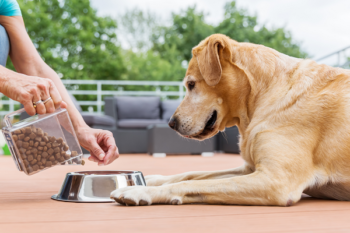
A recent study to assess dog owners’ pet food handling and storage hygiene practices has raised awareness of the FDA’s guidelines for doing just so. Wait, which FDA guidelines? If you didn’t know, don’t worry, because neither did more than 95% of the pet owners who participated in the study.
Harmful bacteria, like Escherichia coli (E. coli), salmonella, and listeria, are happy to reside and multiply on pet food and people food alike, so it makes sense to store and handle all food with the same level of care. Unsure how? Here are three strategies to follow:
1. Purchase pet food with peace of mind
Before you can protect your pet’s food from contamination, start with food that isn’t contaminated. Check the expiry or best before dates on all pet food and consider whether your pet will eat it by that date. Avoid discounted products with damaged packaging, because there is no way of knowing what the contents may have been exposed to. The same goes for cans missing their labels and any packaging that appears discolored, as it could be a result of sitting out in the sun for a long time. Saving 10% is not worth the risk!
The pet food brand you choose is also important. Every brand should have a customer contact phone number printed on its products. Don’t be afraid to call and enquire about their manufacturing safety policies and procedures. If the customer representative can’t answer your questions or direct you to someone who can, do not feed their products to your pets!
2. Handle pet food with care
Start clean, end clean; it’s that simple.
- Wash your hands with soap and hot water for at least 20 seconds before and after handling your pet’s food or treats.
- Prepare your pet’s food on a clean surface, separate from the surface on which you prepare your own food. Clean the surface immediately after each use—the longer you wait, the more time for bacteria to multiply!
- Wash pet food scoops, dishes, and feeders (including Kongs and treat dispensers) after each use, either in the dishwasher or with soap and hot water. Water bowls should be washed daily. According to the study mentioned earlier, swab tests revealed the highest amounts of bacteria found in plastic dishes, but the most harmful bacteria species, including E. coli and methicillin-resistant Staphylococcus aureus, were found most frequently on ceramic dishes. Washing daily minimizes the risk of these bacteria, but stainless steel dishes are the safest option.
- Don’t leave your pet’s food out for the day to be grazed on, as it could attract bacteria-carrying insects and rodents!
3. Make safe and secure storage a priority
Over time, the fat in food oxidizes and becomes rancid, compromising its nutritional value and palatability. Here are some storage tips to keep your pet’s food safe, nutritious, and delicious:
- Unused portions of wet food should be stored in a sealed container in the refrigerator. (There are special lids available for sealing open cans.) After opening, wet food should be consumed within four days or according to the directions on the label.
- Keep kibble and treats in their original packages and sealed tightly between use. If the package doesn’t have a reusable seal, becomes damaged, or you can’t trust your pet to keep his paws off, store the bag in a plastic bin with a secure lid. If you need to dump the kibble into a bin, be sure to wash the bin with soap and hot water between each refill to avoid contamination from accumulated fat residue and crumbs.
- Protect dry food, treats, and unopened cans in a cool, dry place, away from sunlight and pests like rodents and insects.
Keeping your pet’s food safe is a commitment. Pick some small changes you can implement today, like washing your hands and your pet’s dishes more often, then set goals for the more challenging ones, like researching pet foods and reorganizing your storage space.